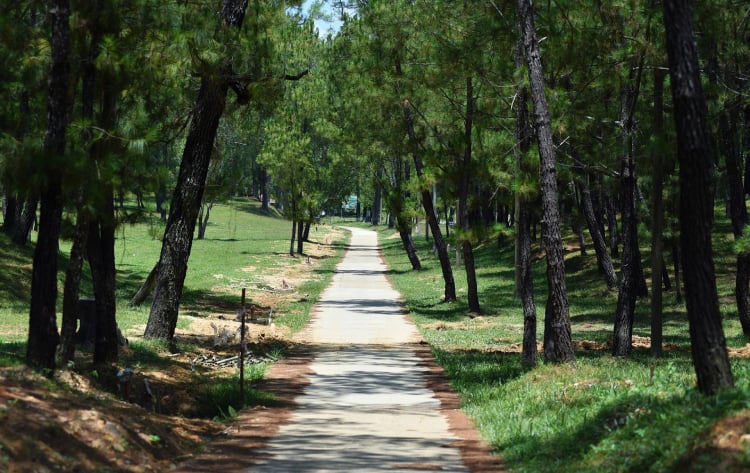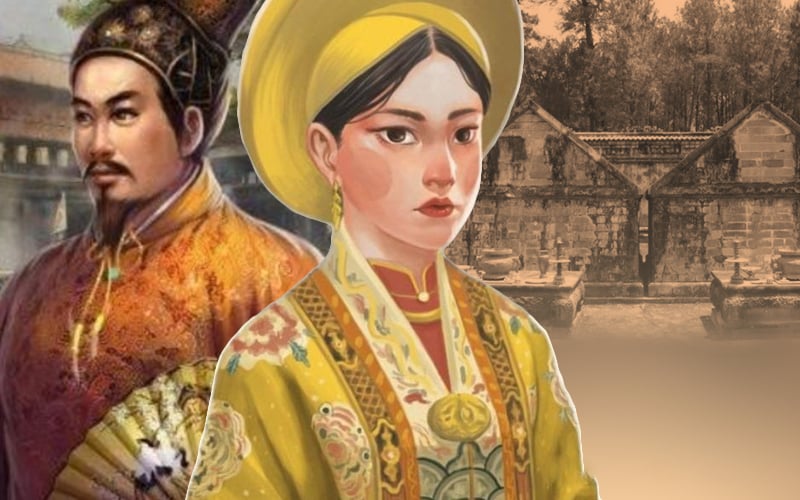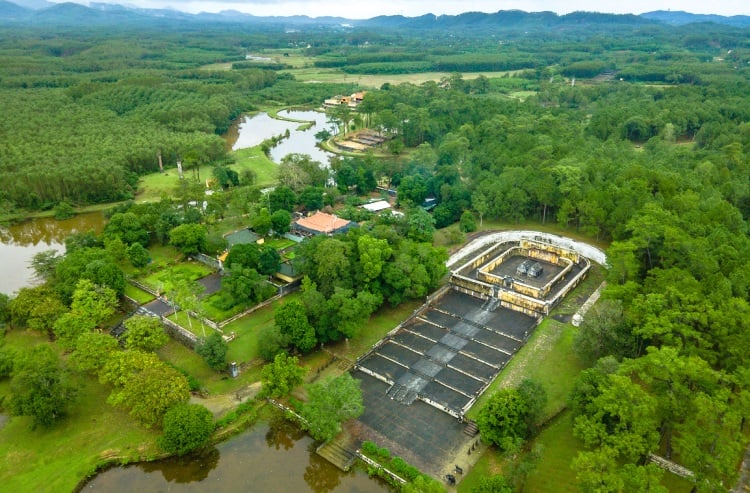Gia Long Tomb is not only the resting place of the founding emperor of the Nguyen Dynasty, but also a testament to his unwavering love and loyalty to the Empress. The two stone tombs lying side by side for centuries symbolize the deep bond and companionship between the Emperor and his Queen—both in life and in the afterlife.
For those passionate about history and culture, visiting the tomb of the first Nguyen emperor is a meaningful experience. Gia Long Tomb is not only considered to have one of the most beautiful feng shui locations among the Nguyen emperors’ mausoleums, but is also famous for the enduring love story between Emperor Gia Long and Empress Thua Thien Cao.
1. Where is Gia Long Tomb? Directions to Thien Tho Tomb
Gia Long’s tomb, also known as Thien Tho Tomb, was built over six years (1814–1820) and includes several smaller tombs of members of the imperial family. The entire complex is nestled in a pristine mountainous area with poetic scenery in Thua Thien Hue Province.


2. The History of Emperor Gia Long and His Eternal Love for Empress Thua Thien Cao
Emperor Gia Long, born in 1762 with the given name Nguyễn Phúc Ánh (commonly known as Nguyễn Ánh), was the founding emperor of the Nguyen Dynasty—the last feudal dynasty in Vietnamese history. He ascended the throne in 1802 and ruled the country until his death in 1820. Known primarily as a powerful military leader, few know that Emperor Gia Long also had a deeply faithful and devoted love for Empress Thua Thien Cao.
Madame Tống Thị Lan, later known as Empress Thua Thien Cao, was the beloved daughter of Tống Phước Khuông, a high-ranking military official. She was not only renowned for her beauty and grace, but also for her refined manners, humility, and respect for court etiquette. Entering the imperial court at the age of 18, she became a primary consort and remained steadfast by the Emperor’s side, supporting him through countless trials and upheavals of the era.

Even as a concubine, she vowed to live and die alongside her husband, skillfully managing domestic affairs and winning the Emperor’s deep admiration and respect.
Their enduring marital devotion moved many, especially through the acts of love the Emperor showed after her passing. In 1814, overwhelmed with grief, Gia Long ordered the construction of a tomb modeled after the ancient tradition of joint burial, so that when he passed away, he could be laid to rest beside his soulmate.

3. Architecture and layout of Gia Long Tomb

The emperor’s mausoleum sits atop a gigantic, flat hill. In front of it stands the Dai Thien Tho Mountain, and behind it are seven mountains that form a protective barrier. On either side, 14 mountains are arranged symmetrically, called “Ta Thanh Long” on the left and “Huu Bach Ho” on the right. It is divided into three distinct areas:
The central area – The tombs of the Emperor and the Empress
The tombs of Emperor Gia Long and Empress Thua Thien Cao are located around the complex. In the center of the complex stands Buu Thanh, situated at the summit of the hill, after a courtyard lined with gigantic stone statues and seven layers of ceremonial platforms. Within Buu Thanh, there are two stone tombs included in a stone chamber, symbolizing the concept of “Can Khon” – the harmonious union of virtues, representing a profound image of loyalty and happiness.
The worship area – Minh Thanh Court
Located to the right of the Gia Long Tomb complex is the ritual area, with the Minh Thanh Court in the middle. This court is the central shrine of worship for the first Emperor and Empress. “Minh Thanh” can be translated as “brilliant perfection” or “to be completed in the future,” which refers to the unfinished decorations of the palace, which lacked painted ribs and fine gilding, as interpreted by scholar L. Cadière. Earlier, Minh Thanh Court was occupied by various remnants of Emperor Gia Long’s war life, including saddles, hats, and belts.
The left area – Bi Dinh and the Stele Pavilion
Bi Dinh is situated on the left side of the mausoleum, and this now houses a gigantic stele upon which is inscribed the epitaph “Thanh Duc Than Cong” (Sacred Virtue and Divine Achievements) written by Emperor Minh Mang himself as an inscription to his father. The epigraph is exceedingly sculpted in flawless precision with masterful expertise in art.
Visitors are able to walk into the neighboring tombs via shaded paths filled with pine and wildflowers. The most well-known of these is Thien Tho Huu Mausoleum, Empress Thuan Thien Cao’s tomb, which occupies a peaceful yet highly symbolic location. Another notable structure is Gia Thanh Court, an architectural parallel to Minh Thanh Court, serving to honor Emperor Minh Mang’s mother, the most successful emperor of the Nguyen Dynasty.
Visiting Gia Long Tomb: What to know
The entrance fee of the Gia Long Tomb Hue is 150,000 VND/adult and free for children.
The most ideal time to visit the Thien Tho Royal Tomb complex is during summer, when the vibrant lotus flowers bloom, filling the air with their sweet scent. The site is particularly lovely during the late afternoon, with breathtaking sunsets.
When the sun goes down behind the hills, the golden light casts shimmering splashes of light dancing on the rippling waters of the lake, fringed by the rustling pines. Such a serene landscape helps tourists best enjoy the majesty and serene beauty of the mausoleum.
